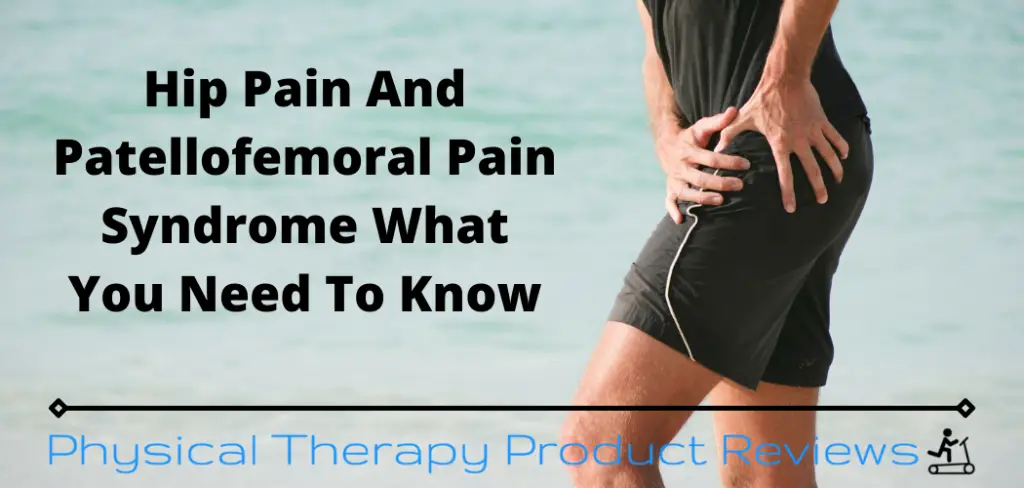Do you have Patellofemoral Pain Syndrome (PFPS)? It’s easy to understand the causes that contribute to knee pain but does it also cause hip pain?
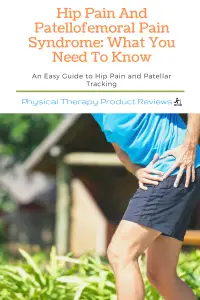 PFPS is an overuse syndrome of the knee cap that causes pain in the front of the knee and is made worse with activities such as squatting, running, and jumping. With obvious symptoms in the knee, is there a correlation with any onset of hip pain?
PFPS is an overuse syndrome of the knee cap that causes pain in the front of the knee and is made worse with activities such as squatting, running, and jumping. With obvious symptoms in the knee, is there a correlation with any onset of hip pain?
This article will examine the relationship between patellofemoral pain and hip pain, how to identify patellofemoral hip problems, and potential treatments for each type of problem.
What is Patellofemoral Pain Syndrome?
In Patellofemoral Pain Syndrome, the Patella is overloaded in an abnormal manner which causes knee discomfort. The Patella acts as a pulley for your quad muscles, but if it becomes overloaded it will cause pain and discomfort. The ligaments, tendons, and other tissue in the kneecap area become sensitive to pressure making activities such as squatting, lifting, and running cause too much stress to handle.
PFPS can take anywhere from 4-8 weeks to heal.
There are other ways to speed up healing such as using a patellar tracking brace, reducing aggravating activities, stretching, foam rolling, and strengthening.
Does Patellofemoral Pain Syndrome Cause Hip Pain?
Can you have Patellofemoral pain and hip pain at the same time? Yes, you can. However, PFPS does not directly cause hip pain. Rather hip pain can be a causative factor in developing PFPS and knee pain
Hip pathology is a common cause of hip weakness, which is a risk factor for Patellofemoral Pain Syndrome.
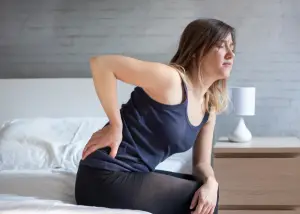
The alignment of the knee and leg’s position during activities is primarily controlled by the hip and the ankle. If the hip isn’t strong enough, then this will defer more pressure to the knee joint. The more the leg moves side to side or is unstable during loading activities such as running, the more irritated the knee will get. This is commonly seen as infrapatellar fat pad syndrome.
If this cycle continues, it increases the risk of more knee pain and more hip weakness which can only make this worse. It will continue to put more pressure on the hip and cause the hip pain to get worse if something isn’t addressed.
Is Hip Strength Important for Patellofemoral Pain Syndrome?
Yes, patellofemoral pain syndrome (PFPS) is a condition that improves with an increase in hip strength.
The stronger the hip muscles are, the better control you’ll have during squatting, descending stairs, and running and the less aggravated the knee cap will be.
Think of it as spreading the forces out more evenly across all the joints in the lower leg.
Is Quad Strengthening Important for Patella Tracking?
Yes, patellofemoral pain syndrome (PFPS) is a condition that greatly benefits from strong quads.
Strengthening the quads will help stabilize and improve patella tracking. The 4 quad muscles work together and prevent excessive pressure to overload the knee cap.
Think of it like this, you want forces to be placed into the large quad muscles instead of concentrated on the small area of the kneecap.
Quad strengthening can be difficult to do with PFPS because a lot of the activities that strengthen the quad also aggravate the knee cap such as squats, stairs, and riding a bike.
There are specific hip strengthening exercises that you can do to strengthen the quad without aggravating the knee.
4 Exercises to Help Strengthen the Hip Without Aggravating PFPS
These 4 exercises are a great place to start for strengthening the hip while also avoiding overloading the knee cap. Improving strength does take 6 weeks or longer so it’s important to be consistent.
Side-Lying Clamshell with a Resistance Band
This is an excellent exercise to strengthen the gluteus medius and minimus. These muscles are important for hip control which can help patellofemoral pain syndrome. Clamshells are a great way to learn how to control the rotation of the leg which is a common aggravator.
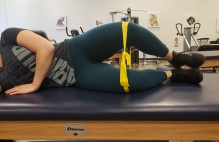
Single-leg Balance with 3-way Banded Hip-Strengthening
This exercise will help strengthen the hip abductors, external rotators, and hip flexors as we all improve your balance. Strengthening these muscles can reduce patellar movement during weight-bearing activities such as running or descending stairs which reduces patellofemoral pain syndrome symptoms. This also helps improve patella tracking to relieve pressure from your knee cap.
The goal of all 3 motions is to keep the knee straight while strengthening to muscles around the knee.
Video Link: https://www.youtube.com/watch?v=e403y-bbKoA
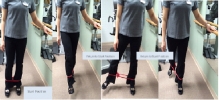
Eccentric Bridge with a Resistance Band
Strengthening your glutes and hamstrings is important for Patellofemoral Pain Syndrome. Eccentric bridge strengthening will help strengthen the hip extensors, hamstring muscles which are crucial to knee stability during weight-bearing activities such as running or squatting.
Start by lying on the back with a band around the knees. Lift your hips up to the ceiling and slowly march one leg up, place it down and then march the other leg. Slowly return to the starting position.
Video Link: https://www.youtube.com/watch?v=GjLPEfu5PN0
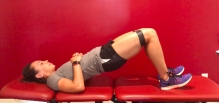
Single-Leg Dead Lift
Strengthening your hamstrings, hip extensors and glutes is important for Patellofemoral Pain Syndrome (PFPS).
Single leg deadlifts help strengthen these muscles in a weight-bearing position. This is also one of our favorites for helping with single leg balance and rotational control.
Start by standing on one leg with the knee slightly bent. Slowly tip yourself forward maintain a straight line from your shoulders to your leg that is also raising up behind you.
To bring yourself up, bring your hips forward instead of leading with the back.
Video Link: https://www.youtube.com/watch?v=Zfr6wizR8rs
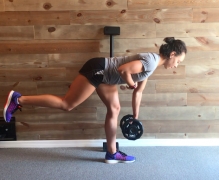
Tips to Help with Hip Pain During Patella Tracking Dysfunction
Wear a Patellar Tracking Brace
A patellar tracking brace can help relieve hip pain during patellofemoral pain syndrome because it reduces patella movement and stabilizes the kneecap.
It can take pressure off the knee cap in a similar manner as the quad normally do and allow for the legs to get stronger with making things worse.
Try Taping the Knee Cap
Taping the patella can help reduce patellar tracking issues that cause hip pain during patellofemoral pain syndrome. It also helps relieve some of your symptoms by reducing pressure on the patella and stabilizing it while you’re in motion which is crucial for running or descending stairs.
You can use Luekotape but this is hard to do if you aren’t in the medical field. We typically recommend use kinesiotape instead.
Foam the Roll the Hip for Pain Control
Foam rolling the hip muscles can help patellofemoral pain syndrome by reducing tightness in your hip flexors, lateral glutes, and other surrounding hip muscles. This will alleviate some of the patellofemoral pain symptoms that cause hip pain.
Be Aware of Body Positioning
Poor patellofemoral tracking and hip pain during patellofemoral syndrome are worsened by poor body positioning.
You should avoid sitting with your knees bent for long periods of time when you have patellofemoral pain because this causes long-term pressure to build on the backside of the knee cap.
It’s also important to be aware of your knee position when you have weight through it.
For example, as you descend the stairs watch your knee and see if moves from side to side a lot or does stay stable in a straight line with the hip and ankle?
Try doing a step in front of the mirror and watch what your knee does.
Conclusion
If you have patellofemoral pain, hip pain is possible to have at the same time. This can be treated with strengthening exercises for the hip muscles while taping or wearing a patellar tracking brace to help reduce symptoms during activities such as running or descending stairs.
Other Great Rehab Related Articles
How to Stay Active After Cervical Fractures: Expert Tips and Advice
Dealing with Painful Stairs After Ankle Replacement Surgery
Walking After a Total Ankle Replacement: Tips for a Successful Recovery
Exercises While Non-Weight Bearing After Ankle Replacement: Elevation, AROM, Leg Raises, and More
Ankle Pain with Stairs: Causes and Home Treatment Options
5 Common Mistakes You’re Making After an Ankle Sprain
Disclaimer: The information provided in this post is for educational purposes only. This is not a substitute for a medical appointment. Please refer to your physician before starting any exercise program.
